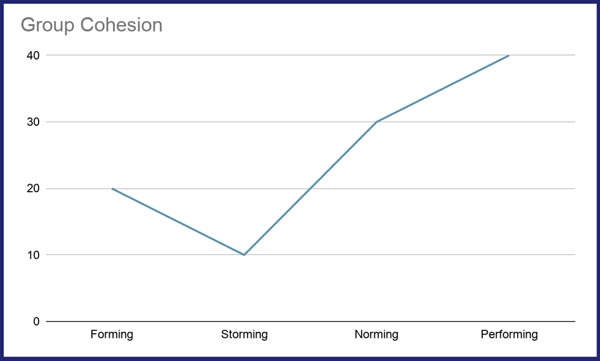Forming storming norming performing is one of the most influential ideas in the study of team development. Its less catchy title is the Tuckman framework, which studies how groups develop and deepen. The heightened interest in team development is taking place not just in the academic and research communities. The business world has also acknowledged the benefits of increased productivity from cohesive teams. More and more businesses are recognizing failures in their teams. That simply arranging people into a formal hierarchy does not necessarily lead to the strongest or most efficient teams.
Each of the steps forming, storming, norming, and performing referred to are a specific and necessary stage in the formation of any cohesive group. Whether or not you’re already familiar with the premise underlying the Tuckman framework, in this article we’ll give a concise overview of the best thinking around how teams form and improve.

Stages of Team Development
If you’ve spent much time in the world of business and/or management, you’re probably already at least a little familiar with the boom in the team development field. Academics are studying it, organizations are assembling conferences devoted to it, and sure enough, many quacks are peddling their ability to teach it. But that shouldn’t disguise the fact that the field has generated powerful insights over the decades.
An early and durable model is the Tuckman model of team development. You may have heard managers speak of forming storming norming performing as if the concept is self-explanatory. Let’s unpack the forming norming storming performing definition.
Forming storming norming performing describes the four essential stages of team development, as first codified in the work of psychologist Bruce Tuckman in 1965. Each of these words represent one stage in the model, which individuals inevitably must go through as they form a group into a team.
[optin-monster slug="oa6kdflxsmp4bi4azzgi" followrules="true"]
Forming Norming Storming Performing Model
Perhaps unsurprisingly, the forming norming storming performing model is a four-stage process whose stages can be labeled as--you guessed it--Forming, Storming, Norming, and Performing.
Let’s take a closer look at just what’s meant by each of these stages. Knowing what to expect from each of the forming, storming, norming, and performing stages can help management team building cohesiveness and success.
Stages of Team Development:
-
Forming
Forming, the first stage, refers to the beginnings of group formation. Team members are introduced to one another and begin to learn about each other on relatively superficial levels. Most members remain optimistic and polite in this stage, though there can be anxiety as well. Most of the real details of the work the team will do, as well as the group dynamic - remain unknown. This stage doesn’t last very long before the actual work begins, and the second phase commences.
-
Storming
The second stage, storming, refers to the storm of activity and accountability that begins when the group first begins its work together. New procedures have not been fully learned or mastered, which combines with other unfamiliar conditions to make for an atmosphere of uncertainty. This can lead to increased chances of stress, anxiety, and conflict. Members begin to sense the minute details as well as the sum total of the work that will be required of them. This is also the stage when some members may begin to compete with one another for power or superiority. This is especially likely if early conflict threatens a shared faith in the leadership structure. Leadership, therefore, is of the utmost importance in moving through this difficult stage.
-
Norming
Luckily, the overwhelming elements of the storming stage are temporary. Norming, the third stage, refers to the fact that the team begins to form norms, agreements, rules, and habits. This usually means smoother operation, less conflict, and more group efficiency. Many of the obvious and unavoidable conflicts of the storming stage have been overcome, or at least temporarily defused. The team begins to develop a sense of confidence, momentum, and ease with their various duties and roles. The need for immediate and constant oversight decreases from its maximum in the storming stage.
-
Performing
The final stage occurs once the team masters its tasks & procedures and develops an ongoing stability in its structure. A level of trust has been built that allows each to thrive in their respective roles. There is very little confusion about who should be doing what or how the members relate to one another. The norms have been internalized. This stage describes the maximum of stability. Teams in the performing stage are better equipped to adapt to change - in membership, conditions, or objectives -without collapsing or succumbing to conflict.
Form Storm Norm Perform Chart
To get a sense of the trajectory of group cohesion over the course of the Tuckman model of team development, see our form storm norm perform chart.

Conclusion
No true leader leads only individuals. True leadership is defined by uniting people under a common sense of purpose. Leaders working in the modern business world would do well to study how groups unite, turning from individuals into teams. The forming storming norming performing model is one of the most powerful tools we have for understanding how teams come together. Developing a deeper understanding of this provides an essential tool for any leader looking to get the most from their team.
Additional Reading:
- Mental Models: What Are They?
- Communication Skills
- Teamwork Skills: Increasing What Employers Value
- The Pyramid Principle